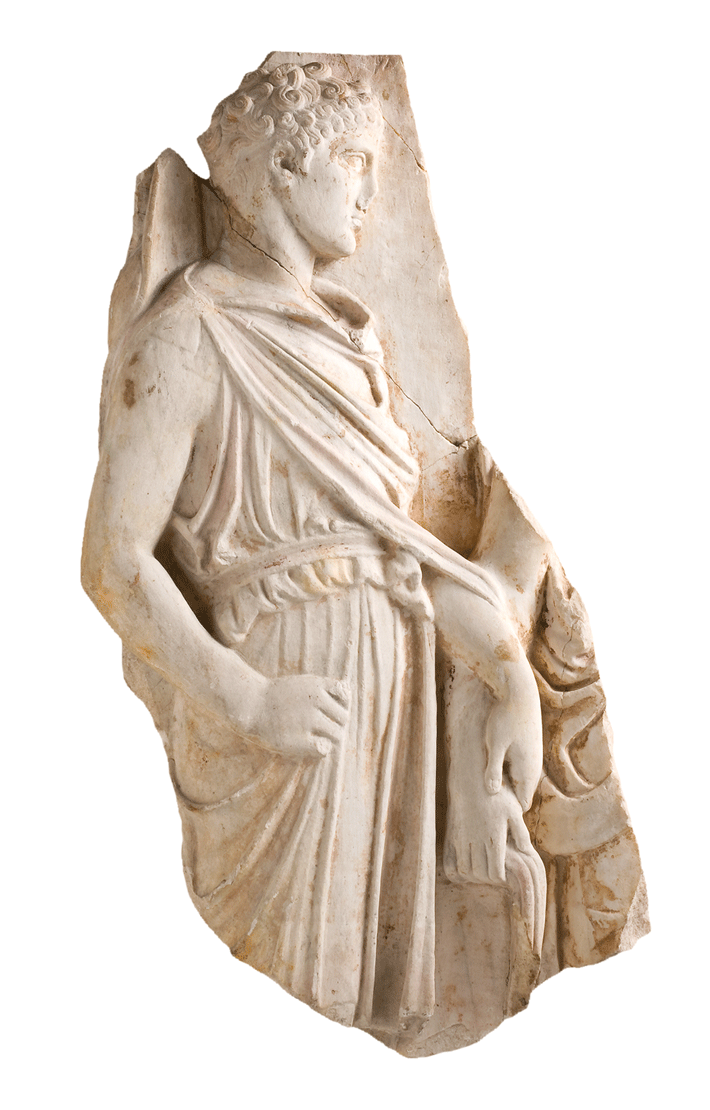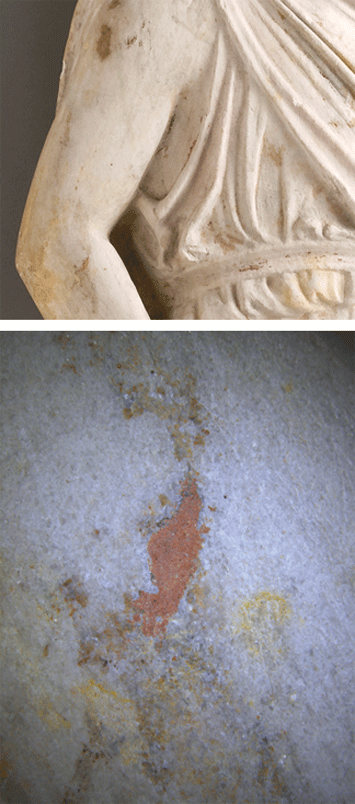IMMAGINI DI FALSI
e
confronto con alcuni reperti autentici
KM 81.4.27. Figure of Girl in Swimming Posture
Wood. Length: 18.2 cm. New Kingdom (ca. 1550-1070 BC)
False
This cosmetic grinder (?), purporting to be an 18th Dynasty (1570-1293 BC) Egyptian artifact, was purchased by a private collector from a reputable auction house in 1956 and subsequently donated to the Kelsey Museum. It came into our collections in 1981, and was only discovered to be spurious in 1992 when Visiting Curator Edna R. Russman studied the piece more closely.
The figure imitates a form of cosmetic spoon or small covered vessel found in some tombs of the 18th Dynasty and (to a lesser extent) later. The little round container, in the shape of a flower or fish, or with a lid in the shape of a water bird or small animal, is held at arms' length by a naked girl, whose body is stretched out horizontally behind her raised head.
These charming objects have been quite popular with forgers; it must be said that this example is among the more attractive of a fairly large group. But false it is, for the following reasons:
- The material:
This wood is very light in weight, which suggests that it may be ancient wood. It is, however, coarse-grained utilitarian stuff, not what one finds for these deluxe items.
- The carving technique:
Similarly, one would expect much attention to detail and careful finishing of the surface, obviously not the case here.
- The object she holds:
This is unique among swimming-girl figures; all other examples hold a small vessel. Uniqueness per se would not, of course, be enough to condemn the object. But deviation from a well-defined class is certainly cause for suspicion…The object itself is unconvincing, because it is unidentifiable. The suggestion that it was meant to function as a grinder becomes absurd when one considers how fragile and ill-designed the figure is for exerting pressure on even a fairly soft substance.
- The anatomy:
It is not only clumsy, but clumsy in an un-Egyptian way; for example, the too-short, elbowless arms; the small, deeply-recessed pubic triangle; the uneven, paddle-shaped feet.
- The vaguely masculine hairdo.
- The face:
More attention has been given to the face than to any other part. It is recognizably modeled on Amarna-type faces, but with a telltale lack of definition, especially in the lower half. This kind of face frequently turns up on small forgeries of New Kingdom material, and it is probably a clue to when this forgery was made, and perhaps even the identity of the maker.

KM 87.12.1-2. Papyrus Rolls
Ink on papyrus, cloth, clay (of modern construction using ancient materials)
Height: 22.5 cm and 17 cm. Third Intermediate Period (1070-656 BC).
Authentic material, false artifact
These made-up papyrus rolls are common artifacts of the practice of 19th-century antiquities dealers, who rolled up fragments of genuine papyrus and wrapped them in strips of ancient cloth to form scrolls. This is evident by, among other things, the fact the the texts and images on the papyrus are turned to the outside of the roll; actual ancient papyrus scrolls generally turn the text and images inside the roll to further protect them.
[Richards, Janet E. and Terry G. Wilfong.1995. Preserving Eternity: Modern Goals, Ancient Intentions. Ann Arbor: Kelsey Museum of Archaeology, University of Michigan.]
KM 26801. Mummy Portrait of a Young Woman
Encaustic on wood. Height: 39.5 cm. Width: 17.0 cm. Thickness: 1.0 cm. Trajanic (98-117 AD).
Authentic.
The mummy portrait of a woman (KM 26801) is an exceptional example of the type of funerary portraiture prevalent among the Romans of the Fayoum region of Egypt. It can be compared with three other forged portraits in the museum's collections (KM 1797, KM 1798, KM 1799) which were collected by the museum's founder, Francis W. Kelsey in 1920. The forgeries are rather crude in comparison to the authentic piece, but the crudeness of the rendering is not the primary reason for a rejection of these pieces as genuine.
Certain technical features immediately suggest that they are not ancient work. The paint (apparently a matte tempera)has been applied directly to the surface of the thin panels. In antiquity, portrait panels were treated to a coat of gesso in preparation for the application of paint (either tempera or encaustic). On these modern panels one can see the grain of the wood through the paint because the wood is young and its grain has not mellowed with age…Our modern panels are rather long compared to the average length of an ancient Fayoum portrait panel.
In terms of style, the modern painter has not captured the depth and richness of of planes which characterize the ancient paintings -- even poorly preserved ones…but since they were all done by the same hand, it is useful nevertheless, to note the similarities which can reveal a shared identity of authorship -- be it ancient or modern.
[Root, Margaret Cool. 1979. Faces of Immortality: Egyptian Mummy Masks, Painted Portraits, and Canopic Jars in the Kelsey Museum of Archaeology. Ann Arbor: Kelsey Museum of Archaeology, University of Michigan.]
A recent development of scholarship has allowed researchers at the Speed Museum in Louisville, Kentucky to attribute a mummy portrait panel in their collection to the hand of the forger of these three panels.Certain technical features immediately suggest that they are not ancient work. The paint (apparently a matte tempera)has been applied directly to the surface of the thin panels. In antiquity, portrait panels were treated to a coat of gesso in preparation for the application of paint (either tempera or encaustic). On these modern panels one can see the grain of the wood through the paint because the wood is young and its grain has not mellowed with age…Our modern panels are rather long compared to the average length of an ancient Fayoum portrait panel.
KM 1797. Fayoum Mummy Portrait
Tempera on wood Height: 44.0 cm. Width: 20.0 cm. Modern False.
KM 1798. Fayoum Mummy Portrait
Tempera on wood Height: 43.5 cm. Width: 21.0 cm. Modern False.
KM 1799. Fayoum Mummy Portrait
Tempera on wood Height: 40.0 cm. Width: 22.0 cm. Modern False.
KM 71.2.193-196. Four Variegated Canopic Jars - Authentic
Limestone with painted details.
KM 71.2.193 (human): Height (jar and lid): 30.8 cm; Max. diameter: 15.2 cm
KM 71.2.194 (baboon): Height (jar and lid): 31.8 cm; Max. diameter: 15.3 cm
KM 71.2.195 (jackal): Height (jar and lid): 31.3 cm; Max. diameter: 15.3 cm
KM 71.2.196 (falcon): Height (jar and lid): 32.0 cm; Max. diameter: 15.0 cm
Late Period (Dyn. XXV-XXX, 712-332 BC)
The set of genuine limestone canopic jars (KM 71.2.193-6) were acquired by the museum in 1971 as a purchase from a collecting society in Bay View, MI. The fraudulent set of alabaster jars (KM 73.1.1-4) was acquired by the museum in 1973 as a gift from an individual.
Each of these sets of jars was intended for the purpose of containing the viscera removed from the body during the mummification process. The figures represented on the jar lids represent deities thought by the ancient Egyptians to protect each individual organ contained in each jar. Additionally, each jar was often inscribed. The inscriptions on the forged set of jars proved to be the critical aspect in this investigation; they are "nonsensical modern additions.In her 1979 catalogue, Margaret Root comments, "Either they [the inscriptions] were added by a dealer in order to increase the market value of an uninscribed set of authentic jars, or else the jars as well as their inscriptions are modern work."
[Root, Margaret Cool. 1979. Faces of Immortality: Egyptian Mummy Masks, Painted Portraits, and Canopic Jars in the Kelsey Museum of Archaeology. Ann Arbor: Kelsey Museum of Archaeology, University of Michigan.]
Subsequent research proved that they were indeed modern, probably originating in the alabaster workshops of Qurna, Egypt, where such forgery activity is known to have taken place.

KM 73.1.1-4. Four Canopic Jars Grouped as a Variegated Set - False
Alabaster, polished and inscribed (lid of KM 73.1.2 made of an opaque stone)
KM 73.1.1 (falcon): Height (jar and lid): 36.3 cm; Max. diameter: 16.0 cm
KM 73.1.2 (jackal): Height (jar and lid): 30.1 cm; Max. diameter: 17.0 cm
KM 73.1.3 (baboon): Height (jar and lid): 37.5 cm; Max. diameter: 16.0 cm
KM 73.1.4 (human): Height (jar and lid): 40.8 cm; Max. diameter: 20.8 cm
Dyn. XVIII, ca. 1550-1307 BC (KM 73.1.4); Dyn XIX, ca. 1307-1196 BC (KM 73.1.1-3)

M 71.2.172. Sculptor's Model of A Man - Authentic
Limestone. Height: approx. 10.5 cm. Ptolemaic Period (332-30 BC)
Both of these sculptures - the genuine (above) and the forgery (below) - were purchased by the museum, the Head of a King coming into the collections in 1925, while the Sculptor's Model of A Man was acquired in 1971 from the Bay View collecting group. Each of these small limestone sculptures is cleanly carved, with dates attributed to the Ptolemaic Period of Egypt (332-30 BC) However, upon closer examination, the Head of a King has been shown to be a forgery.
In 1992, Visiting Curator Edna R. Russman was able to determine that the piece [Head of a King] was similar to other works she has seen by this particular forger, namely in the facial resemblance between the sculptures in this group of fakes. Additionally, the details of the crown are incorrect, with the inclusion of the uraeus and a snake stretched along the center of the head. This combination of elements would not have occurred in a genuine work. Russman felt that the forgery was produced in the early 1920's, and that it was a very well executed forgery, perhaps assisting the forger in fooling experts for almost seventy years.
KM 4971. Head of a King - False
Limestone. Height: approx. 20 cm. Ca. early 1920's
FONTE:
The Art of the Fake: Egyptian Forgeries from the Kelsey Museum of Archeology
Exhibit Curators: Robin Meador-Woodruff, Terry Wilfong and Janet Richards
Exhibit Designer: Anne Noakes









